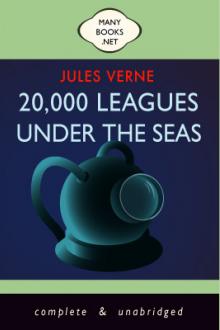Off on a Comet! a Journey through Planetary Space by Jules Verne (robert munsch read aloud .TXT) 📖

- Author: Jules Verne
Book online «Off on a Comet! a Journey through Planetary Space by Jules Verne (robert munsch read aloud .TXT) 📖». Author Jules Verne
Now and then the captain and his friends found themselves speculating whether, in the event of their having to spend another winter upon Gallia, some means could not be devised by which the dreariness of a second residence in the recesses of the volcano might be escaped. Would not another exploring expedition possibly result in the discovery of a vein of coal or other combustible matter, which could be turned to account in warming some erection which they might hope to put up? A prolonged existence in their underground quarters was felt to be monotonous and depressing, and although it might be all very well for a man like Professor Rosette, absorbed in astronomical studies, it was ill suited to the temperaments of any of themselves for any longer period than was absolutely indispensable.
One contingency there was, almost too terrible to be taken into account. Was it not to be expected that the time might come when the internal fires of Gallia would lose their activity, and the stream of lava would consequently cease to flow? Why should Gallia be exempt from the destiny that seemed to await every other heavenly body? Why should it not roll onwards, like the moon, a dark cold mass in space?
In the event of such a cessation of the volcanic eruption, whilst the comet was still at so great a distance from the sun, they would indeed be at a loss to find a substitute for what alone had served to render life endurable at a temperature of 60 degrees below zero. Happily, however, there was at present no symptom of the subsidence of the lava’s stream; the volcano continued its regular and unchanging discharge, and Servadac, ever sanguine, declared that it was useless to give themselves any anxiety upon the matter.
On the 15th of December, Gallia was 276,000,000 leagues from the sun, and, as it was approximately to the extremity of its axis major, would travel only some 11,000,000 or 12,000,000 leagues during the month. Another world was now becoming a conspicuous object in the heavens, and Palmyrin Rosette, after rejoicing in an approach nearer to Jupiter than any other mortal man had ever attained, was now to be privileged to enjoy a similar opportunity of contemplating the planet Saturn. Not that the circumstances were altogether so favorable. Scarcely 31,000,000 miles had separated Gallia from Jupiter; the minimum distance of Saturn would not be less than 415,000,000 miles; but even this distance, although too great to affect the comet’s progress more than had been duly reckoned on, was considerably shorter than what had ever separated Saturn from the earth.
To get any information about the planet from Rosette appeared quite impossible. Although equally by night and by day he never seemed to quit his telescope, he did not evince the slightest inclination to impart the result of his observations. It was only from the few astronomical works that happened to be included in the Dobryna’s library that any details could be gathered, but these were sufficient to give a large amount of interesting information.
Ben Zoof, when he was made aware that the earth would be invisible to the naked eye from the surface of Saturn, declared that he then, for his part, did not care to learn any more about such a planet; to him it was indispensable that the earth should remain in sight, and it was his great consolation that hitherto his native sphere had never vanished from his gaze.
At this date Saturn was revolving at a distance of 420,000,000 miles from Gallia, and consequently 874,440,000 miles from the sun, receiving only a hundredth part of the light and heat which that luminary bestows upon the earth. On consulting their books of reference, the colonists found that Saturn completes his revolution round the sun in a period of 29 years and 167 days, traveling at the rate of more than 21,000 miles an hour along an orbit measuring 5,490 millions of miles in length. His circumference is about 220,000 miles; his superficies, 144,000 millions of square miles; his volume, 143,846 millions of cubic miles. Saturn is 735 times larger than the earth, consequently he is smaller than Jupiter; in mass he is only 90 times greater than the earth, which gives him a density less than that of water. He revolves on his axis in 10 hours 29 minutes, causing his own year to consist of 86,630 days; and his seasons, on account of the great inclination of his axis to the plane of his orbit, are each of the length of seven terrestrial years.
Although the light received from the sun is comparatively feeble, the nights upon Saturn must be splendid. Eight satellites—Mimas, Enceladus, Tethys, Dione, Rhea, Titan, Hyperion, and Japetus—accompany the planet; Mimas, the nearest to its primary, rotating on its axis in 22 1/2 hours, and revolving at a distance of only 120,800 miles, whilst Japetus, the most remote, occupies 79 days in its rotation, and revolves at a distance of 2,314,000 miles.
Another most important contribution to the magnificence of the nights upon Saturn is the triple ring with which, as a brilliant setting, the planet is encompassed. To an observer at the equator, this ring, which has been estimated by Sir William Herschel as scarcely 100 miles in thickness, must have the appearance of a narrow band of light passing through the zenith 12,000 miles above his head. As the observer, however, increases his latitude either north or south, the band will gradually widen out into three detached and concentric rings, of which the innermost, dark though transparent, is 9,625 miles in breadth; the intermediate one, which is brighter than the planet itself, being 17,605 miles broad; and the outer, of a dusky hue, being 8,660 miles broad.
Such, they read, is the general outline of this strange appendage, which revolves in its own plane in 10 hours 32 minutes. Of what matter it is composed, and how it resists disintegration, is still an unsettled question; but it might almost seem that the Designer of the universe, in permitting its existence, had been willing to impart to His intelligent creatures the manner in which celestial bodies are evolved, and that this remarkable ring-system is a remnant of the nebula from which Saturn was himself developed, and which, from some unknown cause, has become solidified. If at any time it should disperse, it would either fall into fragments upon the surface of Saturn, or the fragments, mutually coalescing, would form additional satellites to circle round the planet in its path.
To any observer stationed on the planet, between the extremes of lat. 45 degrees on either side of the equator, these wonderful rings would present various strange phenomena. Sometimes they would appear as an illuminated arch, with the shadow of Saturn passing over it like the hour-hand over a dial; at other times they would be like a semi-aureole of light. Very often, too, for periods of several years, daily eclipses of the sun must occur through the interposition of this triple ring.
Truly, with the constant rising and setting of the satellites, some with bright discs at their full, others like silver crescents, in quadrature, as well as by the encircling rings, the aspect of the heavens from the surface of Saturn must be as impressive as it is gorgeous.
Unable, indeed, the Gallians were to realize all the marvels of this strange world. After all, they were practically a thousand times further off than the great astronomers have been able to approach by means of their giant telescopes. But they did not complain; their little comet, they knew, was far safer where it was; far better out of the reach of an attraction which, by affecting their path,
 Have you ever thought about what fiction is? Probably, such a question may seem surprising: and so everything is clear. Every person throughout his life has to repeatedly create the works he needs for specific purposes - statements, autobiographies, dictations - using not gypsum or clay, not musical notes, not paints, but just a word. At the same time, almost every person will be very surprised if he is told that he thereby created a work of fiction, which is very different from visual art, music and sculpture making. However, everyone understands that a student's essay or dictation is fundamentally different from novels, short stories, news that are created by professional writers. In the works of professionals there is the most important difference - excogitation. But, oddly enough, in a school literature course, you don’t realize the full power of fiction. So using our website in your free time discover fiction for yourself.
Have you ever thought about what fiction is? Probably, such a question may seem surprising: and so everything is clear. Every person throughout his life has to repeatedly create the works he needs for specific purposes - statements, autobiographies, dictations - using not gypsum or clay, not musical notes, not paints, but just a word. At the same time, almost every person will be very surprised if he is told that he thereby created a work of fiction, which is very different from visual art, music and sculpture making. However, everyone understands that a student's essay or dictation is fundamentally different from novels, short stories, news that are created by professional writers. In the works of professionals there is the most important difference - excogitation. But, oddly enough, in a school literature course, you don’t realize the full power of fiction. So using our website in your free time discover fiction for yourself. 




Comments (0)